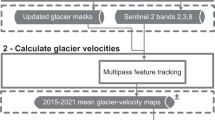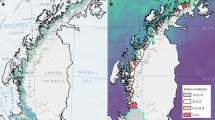Abstract
The effect of climate change on water resources and sea-level rise is largely determined by the size of the ice reservoirs around the world and the ice thickness distribution, which remains uncertain. Here, we present a comprehensive high-resolution mapping of ice motion for 98% of the world’s total glacier area during the period 2017–2018. We use this mapping of glacier flow to generate an estimate of global ice volume that reconciles ice thickness distribution with glacier dynamics and surface topography. After reallocating volume connected to the Antarctic ice sheet, the results suggest that the world’s glaciers have a potential contribution to sea-level rise of 257 ± 85 mm, which is 20% less than previously estimated. At low latitudes, our findings highlight notable changes in freshwater resources, with 34% more ice in the Himalayas and 27% less ice in the tropical Andes of South America, affecting water availability for local populations. This mapping of glacier flow and thickness redefines our understanding of global ice-volume distribution and has implications for the prediction of glacier evolution around the world, since accurate representations of glacier geometry and dynamics are of prime importance to glacier modelling.
This is a preview of subscription content, access via your institution
Access options
Access Nature and 54 other Nature Portfolio journals
Get Nature+, our best-value online-access subscription
$29.99 / 30 days
cancel any time
Subscribe to this journal
Receive 12 print issues and online access
$259.00 per year
only $21.58 per issue
Buy this article
- Purchase on Springer Link
- Instant access to full article PDF
Prices may be subject to local taxes which are calculated during checkout



Similar content being viewed by others
Data availability
Thickness and ice velocity datasets are publicly available at https://doi.org/10.6096/1007. GLACIOCLIM data available at https://glacioclim.osug.fr/; GlaThiDa data available at https://www.gtn-g.ch/data_catalogue_glathida/; RGI available at https://www.glims.org/RGI/; river basins and population data available at www.worldpop.org and https://www.bafg.de.
Change history
12 December 2022
A Correction to this paper has been published: https://doi.org/10.1038/s41561-022-01106-x
References
Hock, R. et al. in Special Report on the Ocean and Cryosphere in a Changing Climate (eds Pörtner, H.-O. et al.) Ch. 2 (IPCC, 2019).
Hugonnet, R. et al. Accelerated global glacier mass loss in the early twenty-first century. Nature 592, 726–731 (2021).
Zemp, M. et al. Global glacier mass changes and their contributions to sea-level rise from 1961 to 2016. Nature 568, 382–386 (2019).
Hock, R. et al. GlacierMIP—a model intercomparison of global-scale glacier mass-balance models and projections. J. Glaciol. 65, 453–467 (2019).
McGranahan, G., Balk, D. & Anderson, B. The rising tide: assessing the risks of climate change and human settlements in low elevation coastal zones. Environ. Urban. 19, 17–37 (2007).
Welty, E. et al. Worldwide version-controlled database of glacier thickness observations. Earth Syst. Sci. Data 12, 3039–3055 (2020).
Huss, M. & Farinotti, D. Distributed ice thickness and volume of all glaciers around the globe. J. Geophys. Res. Earth Surf. 117, f04010 (2012).
Linsbauer, A., Paul, F. & Haeberli, W. Modeling glacier thickness distribution and bed topography over entire mountain ranges with GlabTop: application of a fast and robust approach. J. Geophys. Res. Earth Surf. 117, F03007 (2012).
Farinotti, D. et al. A consensus estimate for the ice thickness distribution of all glaciers on Earth. Nat. Geosci. 12, 168–173 (2019).
Huss, M. & Hock, R. A new model for global glacier change and sea-level rise. Front. Earth Sci. 3, 54 (2015).
Grinsted, A. An estimate of global glacier volume. Cryosphere 7, 141–151 (2013).
Farinotti, D. et al. How accurate are estimates of glacier ice thickness? Results from ITMIX, the Ice Thickness Models Intercomparison eXperiment. Cryosphere 11, 949–970 (2017).
Farinotti, D., Huss, M., Bauder, A., Funk, M. & Truffer, M. A method to estimate the ice volume and ice-thickness distribution of alpine glaciers. J. Glaciol. 55, 422–430 (2009).
Marzeion, B., Jarosch, A. H. & Hofer, M. Past and future sea-level change from the surface mass balance of glaciers. Cryosphere 6, 1295–1322 (2012).
Radić, V. et al. Regional and global projections of twenty-first century glacier mass changes in response to climate scenarios from global climate models. Clim. Dyn. 42, 37–58 (2014).
Zorzut, V. et al. Slope estimation influences on ice thickness inversion models: a case study for Monte Tronador glaciers, North Patagonian Andes. J. Glaciol. https://doi.org/10.1017/jog.2020.64 (2020).
Werder, M. A., Huss, M., Paul, F., Dehecq, A. & Farinotti, D. A Bayesian ice thickness estimation model for large-scale applications. J. Glaciol. 66, 137–152 (2020).
Millan, R. et al. Vulnerability of Southeast Greenland glaciers to warm Atlantic water from Operation IceBridge and Ocean Melting Greenland data. Geophys. Res. Lett. 45, 2688–2696 (2018).
Morlighem, M. et al. BedMachine v3: complete bed topography and ocean bathymetry mapping of Greenland from multibeam echo sounding combined with mass conservation. Geophys. Res. Lett. 44, 11051–11061 (2017).
Larsen, C. F. et al. Surface melt dominates Alaska glacier mass balance. Geophys. Res. Lett. 42, 5902–5908 (2015).
Millan, R., Mouginot, J. & Rignot, E. Mass budget of the glaciers and ice caps of the Queen Elizabeth Islands, Canada, from 1991 to 2015. Environ. Res. Lett. 12, 024016 (2017).
Mouginot, J. & Rignot, E. Ice motion of the Patagonian Icefields of South America: 1984–2014. Geophys. Res. Lett. 42, 1441–1449 (2015).
Dehecq, A. et al. Twenty-first century glacier slowdown driven by mass loss in High Mountain Asia. Nat. Geosci. 12, 22–27 (2019).
Gardner, A. S., Fahnestock, M. & Scambos, T. ITS_LIVE Regional Glacier and Ice Sheet Surface Velocities (NSIDC, 2020).
Millan, R. et al. Mapping surface flow velocity of glaciers at regional scale using a multiple sensors approach. Remote Sens. 11, 2498 (2019).
Randolph Glacier Inventory 6.0 (RGI Consortium, 2017); https://doi.org/10.7265/N5-RGI-60
Michel, R. & Rignot, E. Flow of glaciar Moreno, Argentina, from the repeat-pass shuttle imaging radar images: comparison of the phase correlation method with radar interferometry. J. Glaciol. 45, 93–100 (1999).
Mouginot, J., Rignot, E., Scheuchl, B. & Millan, R. Comprehensive annual ice sheet velocity mapping using Landsat-8, Sentinel-1, and RADARSAT-2 data. Remote Sens. 9, 364 (2017).
Cuffey, K. & Paterson, W. S. B. The Physics of Glaciers (Butterworth-Heinemann/Elsevier, 2010).
Gaillardet, J. et al. OZCAR: the French network of critical zone observatories. Vadose Zone J. 17, 180067 (2018).
Lambrecht, A., Mayer, C., Aizen, V., Floricioiu, D. & Surazakov, A. The evolution of Fedchenko glacier in the Pamir, Tajikistan, during the past eight decades. J. Glaciol. 60, 233–244 (2014).
Björnsson, H. & Pálsson, F. Radio-echo soundings on Icelandic temperate glaciers: history of techniques and findings. Ann. Glaciol. https://doi.org/10.1017/aog.2020.10 (2020).
Dowdeswell, J. A. et al. Form and flow of the Academy of Sciences Ice Cap, Severnaya Zemlya, Russian High Arctic. J. Geophys. Res. Solid Earth https://doi.org/10.1029/2000JB000129 (2002).
Azam, M. F. et al. From balance to imbalance: a shift in the dynamic behaviour of Chhota Shigri glacier, western Himalaya, India. J. Glaciol. 58, 315–324 (2012).
Wagnon, P. et al. Seasonal and annual mass balances of Mera and Pokalde glaciers (Nepal Himalaya) since 2007. Cryosphere 7, 1769–1786 (2013).
Millan, R. et al. Ice thickness and bed elevation of the northern and southern Patagonian icefields. Geophys. Res. Lett. https://doi.org/10.1029/2019GL082485 (2019).
Morlighem, M. et al. Deep glacial troughs and stabilizing ridges unveiled beneath the margins of the Antarctic ice sheet. Nat. Geosci. https://doi.org/10.1038/s41561-019-0510-8 (2019).
Huss, M. & Hock, R. Global-scale hydrological response to future glacier mass loss. Nat. Clim. Change 8, 135–140 (2018).
Soruco, A. et al. Contribution of glacier runoff to water resources of La Paz city, Bolivia (16° S). Ann. Glaciol. 56, 147–154 (2015).
Lutz, A. F., Immerzeel, W. W., Shrestha, A. B. & Bierkens, M. F. P. Consistent increase in High Asia’s runoff due to increasing glacier melt and precipitation. Nat. Clim. Change 4, 587–592 (2014).
Dussaillant, I. et al. Two decades of glacier mass loss along the Andes. Nat. Geosci. 12, 802–808 (2019).
World Imagery (Esri, accessed 19 May 2019); https://www.arcgis.com/home/item.html?id=10df2279f9684e4a9f6a7f08febac2a9
Meier, F. & Post, A. What are glacier surges? Can. J. Earth Sci. 6, 807–817 (1969).
Abrams, M., Crippen, R. & Fujisada, H. ASTER Global Digital Elevation Model (GDEM) and ASTER Global Water Body Dataset (ASTWBD). Remote Sens. 12, 1156 (2020).
TanDEM-X - Digital Elevation Model (DEM) - Global, 90 m (German Aerospace Center, 2018); https://doi.org/10.15489/JU28HC7PUI09
Porter, C. et al. ArcticDEM (Polar Geospatial Center, 2018); https://doi.org/10.7910/DVN/OHHUKH
Bamber, J. L., Hardy, R. J. & Joughin, I. An analysis of balance velocities over the Greenland ice sheet and comparison with synthetic aperture radar interferometry. J. Glaciol. 46, 67–74 (2000).
Acknowledgements
R.M. acknowledges support from a post-doctoral fellowship awarded by the French Centre National d’Etudes Spatiales (CNES). J.M. and A.R. acknowledge support from the CNES MaiSON project and Labex OSUG@2020 (Investissements d’avenir - ANR10 LABX56). M.M. acknowledges support from MEASURES‐3 project (NASA grant 80NSSC18M0083). We gratefully acknowledge CNES, ESA, Copernicus Program, NASA and Deutsches Zentrum für Luft- und Raumfahrt e.V. for providing the observation used in this paper (Landsat 8, ASTER, Sentinel-1 and 2, TanDEM-X, Venµs). We thank the RGI and GlaThiDa, the Service National d’Observation GLACIOCLIM, the worldpop and BFG for the glacier basins, ice thickness, river basins and population data. The computing/storage resources (about 4 MCPU-hours and 100 Tb) used for this work were provided by high-performance clusters from GRICAD (Grenoble Alpes Recherche - Infrastructure de Calcul Intensif et de Données). Maps in Fig. 3 were created using ArcGIS software by Esri. ArcGIS and ArcMap are the intellectual property of Esri and are used herein under license. Copyright © Esri. All rights reserved. For more information about Esri software, please visit www.esri.com.
Author information
Authors and Affiliations
Contributions
R.M., J.M., A.R. and M.M. conceived and designed the research. R.M. and J.M. performed the experiments. R.M., J.M. and A.R. analysed the data. R.M., J.M., A.R. and M.M. wrote the paper.
Corresponding author
Ethics declarations
Competing interests
The authors declare no competing interests.
Peer review
Peer review information
Nature Geoscience thanks Leigh Stearns, Adrian Luckman and the other, anonymous, reviewer(s) for their contribution to the peer review of this work. Primary Handling Editor: Tom Richardson.
Additional information
Publisher’s note Springer Nature remains neutral with regard to jurisdictional claims in published maps and institutional affiliations.
Supplementary information
Supplementary Information
Supplementary Figs. 1–13 and Tables 1–3.
Supplementary Table 4
Median value of the creep parameter A for all processed regions s−1 Pa−3.
Rights and permissions
Springer Nature or its licensor (e.g. a society or other partner) holds exclusive rights to this article under a publishing agreement with the author(s) or other rightsholder(s); author self-archiving of the accepted manuscript version of this article is solely governed by the terms of such publishing agreement and applicable law.
About this article
Cite this article
Millan, R., Mouginot, J., Rabatel, A. et al. Ice velocity and thickness of the world’s glaciers. Nat. Geosci. 15, 124–129 (2022). https://doi.org/10.1038/s41561-021-00885-z
Received:
Accepted:
Published:
Issue Date:
DOI: https://doi.org/10.1038/s41561-021-00885-z
This article is cited by
-
Review of glacier velocity and facies characterization techniques using multi-sensor approach
Environment, Development and Sustainability (2024)
-
Two Decades of Glacier and Glacial Lake Change in the Dhauladhar Mountain Range, Himachal Himalayas, India (2000–2020)
Journal of the Indian Society of Remote Sensing (2024)
-
The foundations of the Patagonian icefields
Communications Earth & Environment (2024)
-
Unchanged frequency and decreasing magnitude of outbursts from ice-dammed lakes in Alaska
Nature Communications (2023)
-
Three scientists on the front line of climate and conservation research
Nature (2023)



